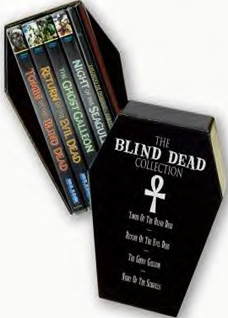 THE
BLIND DEAD COLLECTION
THE
BLIND DEAD COLLECTIONSpanish director/screenwriter
Amando de Ossorio became a fixture during the Spanish horror boom of the early
70s, helming a number of chillers seen all over the world. But de Ossorio will
best be remembered as the man who gave us the “Blind Dead,” eyeless,
blackened corpses, who ride on their undead horses (!), rising from the grave
centuries after their demise to claim new victims. These zombified beings were
once Templar Knights who tortured and sacrificed young women, drinking their
blood and sometimes consuming their hearts! The Templars where condemned to
death as heretics and had their eyes eaten out by crows (or they were burnt
to a crisp by torches, depending on which movie you’re viewing), so when
they returned to life as sightless menaces, they had to rely on sound to stalk
their victims -- all too easy as just about anybody would be screaming at the
sight of them! Starting with 1971’s LA NOCHE DEL TERROR CIEGO, three unrelated
sequels followed, giving us some of some of the scariest-looking monsters ever
put up on the screen, and although de Ossorio’s films owe a bit to George
Romero’s NIGHT OF THE LIVING DEAD, they have a unique style of their own
and a hauntingly atmospheric value that’s never been equaled. Previously
only the first two “Blind Dead” films were available on DVD through
a flawed Anchor Bay release (now out of print), but Blue Underground’s
long-awaited collection of all four entries is a must-have in high definition,
and comes in a nice sturdy coffin box to boot!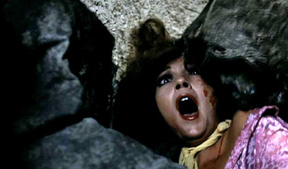
LA NOCHE DEL TERROR CIEGO ("The Night of the Blind Terror") is best known to audiences as TOMBS OF THE BLIND DEAD. Young Virginia White (Elena Arpón) and Roger Whelan (César Burner) are on holiday at a resort when Virginia spots old school friend Betty Turner (Lone Fleming). It seems that the two ladies had a romantic fling some years ago, but now Roger has sights on Betty, making Virginia awfully jealous. Roger immediately invites Betty on their camping trip the next day, but the flirtatious behavior between the two causes Virginia to jump off their train, taking off for the deserted ruins of Berzano, a literal ghost town in the middle of nowhere. Not long after Virginia sets up camp for the night in an ancient monastery, the centuries-old Templar Knights rise from their graves to pursue her. She manages to ride off on one of the knights' horses but is soon captured and mutilated to death. When Roger and Betty later search for their friend, they learn of her murder and their investigation to find the culprits leads them into the nightmare world of the living dead!
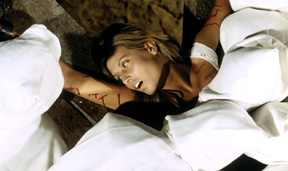 Despite
its low budget and sometimes slow pacing, TOMBS OF THE BLIND DEAD is a classic
in its own right and it’s easy to see why this brought so much attention
to Spanish genre films. With their horrifying unique look, the Blind Dead are
seen rising from their crypts, and then riding off on horseback in effective
slow-mo. Their victims are often struck by their enormous swords and then massacred
by a huddle of knights in vampiric fashion. De Ossorio’s sense of style
is complimented by the eerie music by Antón García Abril, mainly
heard as a series of unearthly chants, and wisely used again in all three follow-ups.
TOMBS is also the only film in the series to have one of the Templars’
victims come back to life as a zombie, in this case Virginia. Seen as bruised
and bandaged after her autopsy, she rises from the slab to put the bite on the
creepy morgue attendant, and then ends up being set on fire in a mannequin shop!
Despite
its low budget and sometimes slow pacing, TOMBS OF THE BLIND DEAD is a classic
in its own right and it’s easy to see why this brought so much attention
to Spanish genre films. With their horrifying unique look, the Blind Dead are
seen rising from their crypts, and then riding off on horseback in effective
slow-mo. Their victims are often struck by their enormous swords and then massacred
by a huddle of knights in vampiric fashion. De Ossorio’s sense of style
is complimented by the eerie music by Antón García Abril, mainly
heard as a series of unearthly chants, and wisely used again in all three follow-ups.
TOMBS is also the only film in the series to have one of the Templars’
victims come back to life as a zombie, in this case Virginia. Seen as bruised
and bandaged after her autopsy, she rises from the slab to put the bite on the
creepy morgue attendant, and then ends up being set on fire in a mannequin shop!
 Blue
Underground’s transfer of the 97-minute Spanish version (LA NOCHE DEL
TERROR CIEGO) is a vast improvement over the old Anchor Bay edition, with luscious
colors, excellent detail, a very clean image and crisp sound. Presented 1.66:1
anamorphic and accompanied with optional English subtitles, this fully uncut
version is preferable, as it contains such exploitation as the Templars’
ultra violent flashback attack (switched around and heavily censored in the
American cut) on a bare-breasted casualty (played by an uncredited Britt Nichols!),
an uncomfortable rape scene, some silly soft lesbian kissing, and other bits
that make it much longer and much more interesting. The edited English language
version (with the onscreen title, “The Blind Dead”) is also included,
running a mere 83 minutes. Also presented 1.66:1 and anamorphic, it looks far
darker and muddier as compared to the beautiful Spanish transfer, but it’s
interesting just to see what AIP released to theaters for Stateside audiences
in 1973 (it was often co-billed with Mario Bava’s TWITCH OF THE DEATH
NERVE). Extras on this disc include a lengthy still and poster gallery, an international
trailer, and most interestingly, an alternate opening sequence for when the
film actually played as “Revenge of the Planet Ape”!
Blue
Underground’s transfer of the 97-minute Spanish version (LA NOCHE DEL
TERROR CIEGO) is a vast improvement over the old Anchor Bay edition, with luscious
colors, excellent detail, a very clean image and crisp sound. Presented 1.66:1
anamorphic and accompanied with optional English subtitles, this fully uncut
version is preferable, as it contains such exploitation as the Templars’
ultra violent flashback attack (switched around and heavily censored in the
American cut) on a bare-breasted casualty (played by an uncredited Britt Nichols!),
an uncomfortable rape scene, some silly soft lesbian kissing, and other bits
that make it much longer and much more interesting. The edited English language
version (with the onscreen title, “The Blind Dead”) is also included,
running a mere 83 minutes. Also presented 1.66:1 and anamorphic, it looks far
darker and muddier as compared to the beautiful Spanish transfer, but it’s
interesting just to see what AIP released to theaters for Stateside audiences
in 1973 (it was often co-billed with Mario Bava’s TWITCH OF THE DEATH
NERVE). Extras on this disc include a lengthy still and poster gallery, an international
trailer, and most interestingly, an alternate opening sequence for when the
film actually played as “Revenge of the Planet Ape”!
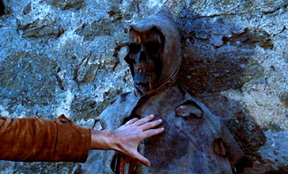 RETURN
OF THE EVIL DEAD (1973) explains that the Templars, swearing that they will
come back one day, had their eyes scalded out and were put to death by angry
villagers. Hundreds of years later, pyrotechnician Jack Marlowe (Tony Kendall),
arrives in Berzano to handle the fireworks at an anniversary celebration, as
it’s been 500 years since the Templars were brought down. He runs into
old girlfriend Vivienne (Esperanza Roy), who is still in love with him despite
being engaged to the sleazy Mayor Duncan (Fernando Sancho). These domestic troubles
are nothing compared to what is to follow: the Templars once again rise from
their graves on horseback and crash the big party. Some of the survivors end
up boarding themselves up in an old church, with the Blind Dead pounding on
the doors outside, tirsty for human blood.
RETURN
OF THE EVIL DEAD (1973) explains that the Templars, swearing that they will
come back one day, had their eyes scalded out and were put to death by angry
villagers. Hundreds of years later, pyrotechnician Jack Marlowe (Tony Kendall),
arrives in Berzano to handle the fireworks at an anniversary celebration, as
it’s been 500 years since the Templars were brought down. He runs into
old girlfriend Vivienne (Esperanza Roy), who is still in love with him despite
being engaged to the sleazy Mayor Duncan (Fernando Sancho). These domestic troubles
are nothing compared to what is to follow: the Templars once again rise from
their graves on horseback and crash the big party. Some of the survivors end
up boarding themselves up in an old church, with the Blind Dead pounding on
the doors outside, tirsty for human blood.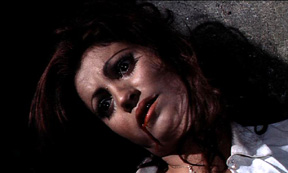
RETURN OF THE EVIL DEAD in many ways is an improvement over the first film, with the rotted Templars getting more screen time, and the central characters being a tad more interesting. The pacing is also better, and the idea of the zombies stomping on a village of sloshed partygoers, flirty women and brawling macho men makes for great entertainment. Having survivors locking themselves in a church to evade the undead again invokes NIGHT OF THE LIVING DEAD, but de Ossorio’s film is filled with enough originality and mood to excuse any comparisons.
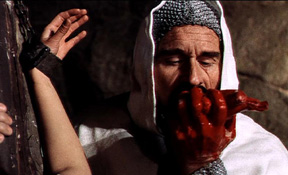 The
disc includes the original uncut Spanish version (91 minutes) seen in the U.S.
for the first time with English subtitles. This version restores outrageous
gore as the Templars devour a female sacrifice in flashback, as well as a sequence
where the village idiot/hunchback (José Canalejas) captures and mutilates
a pretty local girl in order to revive the dead. This sequence was totally eliminated
from the English version (87 minutes) which is also included on this disc. Presented
1.66:1 and anamorphic, the English version looks really nice, with bright colors
and good definition. The preferred Spanish version (EL ATAQUE DE LOS MUERTOS
SIN OJOS) is slightly inferior, looking darker and grainier than its counterpart.
Audio on both is fine, with one brief but loud pop heard on the Spanish version.
Extras include a lengthy still and poster gallery (featuring some female nude
shots not seen in any of the final versions) and an international theatrical
trailer.
The
disc includes the original uncut Spanish version (91 minutes) seen in the U.S.
for the first time with English subtitles. This version restores outrageous
gore as the Templars devour a female sacrifice in flashback, as well as a sequence
where the village idiot/hunchback (José Canalejas) captures and mutilates
a pretty local girl in order to revive the dead. This sequence was totally eliminated
from the English version (87 minutes) which is also included on this disc. Presented
1.66:1 and anamorphic, the English version looks really nice, with bright colors
and good definition. The preferred Spanish version (EL ATAQUE DE LOS MUERTOS
SIN OJOS) is slightly inferior, looking darker and grainier than its counterpart.
Audio on both is fine, with one brief but loud pop heard on the Spanish version.
Extras include a lengthy still and poster gallery (featuring some female nude
shots not seen in any of the final versions) and an international theatrical
trailer.
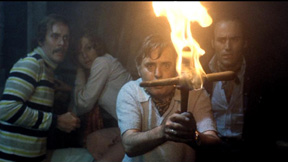 THE
GHOST GALLEON (1974) is often considered the least of the Blind Dead features,
but is not without its merits. Two photographer's models on a publicity stunt
are missing at sea, ending up on an ancient ghost ship. A search party of diverse
characters comes looking for them, only to confront the undead Templars who
creep out of wooden caskets from the bottom of the ship. THE GHOST GALLEON is
slowly paced, and despite having Spanish horror film favorites Jack Taylor and
Maria Perschy, the characters are mostly uninteresting, making the brief appearances
by the Blind Dead all the more welcomed (they only kill one victim on screen,
a raspy voiced annoying blond). The budget also looks poorer than ever, with
a laughable model ship that wouldn’t even cut it for a Tidy Bowl commercial.
The Templars are mostly confined to the boat, and thus never seen on horseback,
but despite it being the least exploitive and least exciting of the four entries,
it still has some good moments.
THE
GHOST GALLEON (1974) is often considered the least of the Blind Dead features,
but is not without its merits. Two photographer's models on a publicity stunt
are missing at sea, ending up on an ancient ghost ship. A search party of diverse
characters comes looking for them, only to confront the undead Templars who
creep out of wooden caskets from the bottom of the ship. THE GHOST GALLEON is
slowly paced, and despite having Spanish horror film favorites Jack Taylor and
Maria Perschy, the characters are mostly uninteresting, making the brief appearances
by the Blind Dead all the more welcomed (they only kill one victim on screen,
a raspy voiced annoying blond). The budget also looks poorer than ever, with
a laughable model ship that wouldn’t even cut it for a Tidy Bowl commercial.
The Templars are mostly confined to the boat, and thus never seen on horseback,
but despite it being the least exploitive and least exciting of the four entries,
it still has some good moments.
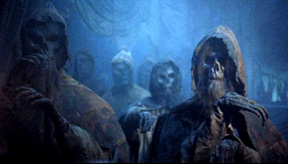 When
Independent International released the film as HORROR OF THE ZOMBIES in the
U.S., they didn’t tamper with it, so basically one version of it exists,
unless you count the slightly edited TV print. THE GHOST GALLEON is here issued
uncut with either Spanish or English language options. Presented in its original
1.85:1 aspect ratio with anamorphic enhancement, the clean transfer has very
strong colors, deep blacks and nice picture detail. Mostly set during the night,
some scenes look a bit dark, but overall the transfer is splendid, with both
audio options coming off strong. Included is an international trailer (which
ballyhoos it as “an important film”), a U.S. trailer and TV spot,
as well as a couple of U.S. radio spots, all under the HORROR OF THE ZOMBIES
title. Another impressive still and poster gallery rounds out the extras.
When
Independent International released the film as HORROR OF THE ZOMBIES in the
U.S., they didn’t tamper with it, so basically one version of it exists,
unless you count the slightly edited TV print. THE GHOST GALLEON is here issued
uncut with either Spanish or English language options. Presented in its original
1.85:1 aspect ratio with anamorphic enhancement, the clean transfer has very
strong colors, deep blacks and nice picture detail. Mostly set during the night,
some scenes look a bit dark, but overall the transfer is splendid, with both
audio options coming off strong. Included is an international trailer (which
ballyhoos it as “an important film”), a U.S. trailer and TV spot,
as well as a couple of U.S. radio spots, all under the HORROR OF THE ZOMBIES
title. Another impressive still and poster gallery rounds out the extras.
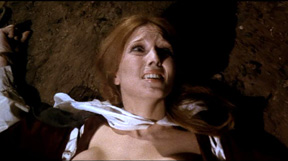 The
final installment, 1975’s NIGHT OF THE SEAGULLS, brought the series back
to basics, and back to dry land. It starts with a flashback to the middle ages,
and the Templars attacking a young couple. They off the man right away, but
they bring the redheaded, breast-augmented female back to the castle for another
gory sacrifice (this time to a monstrous idol). In the 20th century, Dr. Henry
Stein (Victor Petit) and his beautiful wife Joan (Maria Kosti) arrive at a backward
seaside village, where they are unwelcome by everyone, all but a village idiot
and young girl who becomes their maid. Soon they experience the strange sounds
of seagulls during the middle of the night, and discover that the townsfolk
have a strange habit of leaving nightly seaside sacrifices – in the form
of the pretty young ladies – for the Blind Dead who arrive at the scene
to collect!
The
final installment, 1975’s NIGHT OF THE SEAGULLS, brought the series back
to basics, and back to dry land. It starts with a flashback to the middle ages,
and the Templars attacking a young couple. They off the man right away, but
they bring the redheaded, breast-augmented female back to the castle for another
gory sacrifice (this time to a monstrous idol). In the 20th century, Dr. Henry
Stein (Victor Petit) and his beautiful wife Joan (Maria Kosti) arrive at a backward
seaside village, where they are unwelcome by everyone, all but a village idiot
and young girl who becomes their maid. Soon they experience the strange sounds
of seagulls during the middle of the night, and discover that the townsfolk
have a strange habit of leaving nightly seaside sacrifices – in the form
of the pretty young ladies – for the Blind Dead who arrive at the scene
to collect!
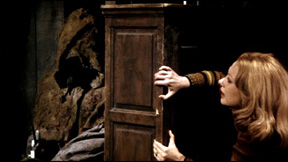 You
would think that by this time there was little that could be done with the undead
Templars, but NIGHT OF THE SEAGULLS is a worthy capping to the gothic quartet.
The Blind Dead still look scary as over, and scenes of them riding in slow motion
along the shoreline are really effective (some footage of the dead rising is
borrowed from the first film – it was recycled for the second film as
well – but it’s totally unnecessary here). We actually get a clearer
view of the zombies here, and they even have an impressive castle, and an even
more impressive demise, complete with pools of blood shooting from their eye
sockets! The film possesses a dreamlike quality (the souls of the sacrificial
offers are believed to enter the seagulls that fly by night) that the others
doesn’t. Julia Saly (here billed as Julie James) appears as one of the
Blind Dead’s victims, and she would soon go on to be one of Paul Naschy’s
most popular leading ladies.
You
would think that by this time there was little that could be done with the undead
Templars, but NIGHT OF THE SEAGULLS is a worthy capping to the gothic quartet.
The Blind Dead still look scary as over, and scenes of them riding in slow motion
along the shoreline are really effective (some footage of the dead rising is
borrowed from the first film – it was recycled for the second film as
well – but it’s totally unnecessary here). We actually get a clearer
view of the zombies here, and they even have an impressive castle, and an even
more impressive demise, complete with pools of blood shooting from their eye
sockets! The film possesses a dreamlike quality (the souls of the sacrificial
offers are believed to enter the seagulls that fly by night) that the others
doesn’t. Julia Saly (here billed as Julie James) appears as one of the
Blind Dead’s victims, and she would soon go on to be one of Paul Naschy’s
most popular leading ladies.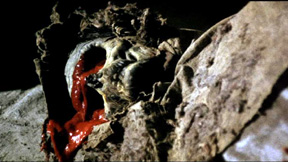
NIGHT OF THE SEAGULLS is presented uncut, in the 1.85:1 ratio with anamorphic enhancement. Another clean and pleasant transfer, the image looks quite good despite a lot of soft focus and “day for night” photography, with some minor grain here and there. Colors are subdued but look accurate, and solid English language and Spanish language tracks are included. The extras are an original international trailer, as well as another great still and poster gallery.
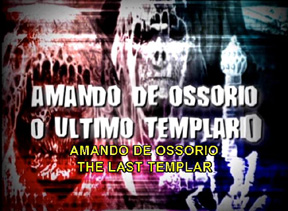 Each
of the films are available separately (with great original poster-art covers),
but the box set contains a fifth disc of bonus materials, Amando de Ossorio:
Director, packaged in a slim keepcase. A 25-minute Spanish-made documentary,
"The Last Templar" takes a fascinating look at de Ossorio’s
career, from his early films to the horror epics he’s known for. He himself
is interviewed, as well as American-born Jack Taylor (speaking in Spanish!),
actress Lone Fleming (who tells a great story about drinking wine during her
uncomfortable lesbian scene in TOMBS OF THE BLIND DEAD), actress Esperanza Roy,
and even Paul Naschy. "Unearthing the Blind Dead," is an 11-minute
interview with de Ossorio done shortly before his death, and he discusses different
aspects about each of the Blind Dead films. Both featurettes are entirely in
Spanish with English subtitles, and they’re so good you only wish they
were longer. The last item on the disc is DVD-ROM article that discusses the
director’s career, written by Mike Hodges shortly after de Ossorio's death.
Also included in the box is an attractive booklet, a reprinting of Midnight
Media’s Knights of Terror, written by Nigel J. Burrell. This
“2005 Revised Edition” is well written, telling you everything you
need to know about the Blind Dead, and housing a lot of great photos and advertising
art. (George
R. Reis)
Each
of the films are available separately (with great original poster-art covers),
but the box set contains a fifth disc of bonus materials, Amando de Ossorio:
Director, packaged in a slim keepcase. A 25-minute Spanish-made documentary,
"The Last Templar" takes a fascinating look at de Ossorio’s
career, from his early films to the horror epics he’s known for. He himself
is interviewed, as well as American-born Jack Taylor (speaking in Spanish!),
actress Lone Fleming (who tells a great story about drinking wine during her
uncomfortable lesbian scene in TOMBS OF THE BLIND DEAD), actress Esperanza Roy,
and even Paul Naschy. "Unearthing the Blind Dead," is an 11-minute
interview with de Ossorio done shortly before his death, and he discusses different
aspects about each of the Blind Dead films. Both featurettes are entirely in
Spanish with English subtitles, and they’re so good you only wish they
were longer. The last item on the disc is DVD-ROM article that discusses the
director’s career, written by Mike Hodges shortly after de Ossorio's death.
Also included in the box is an attractive booklet, a reprinting of Midnight
Media’s Knights of Terror, written by Nigel J. Burrell. This
“2005 Revised Edition” is well written, telling you everything you
need to know about the Blind Dead, and housing a lot of great photos and advertising
art. (George
R. Reis)